The thought of daylight savings and baby sleep might make you feel anxious about disruptions to your child’s naps and nighttime arising from the time change. And for good reason.
The bi-annual clock change of daylight savings can wreak havoc on your baby’s sleep schedule.
Thankfully, this article will give you expert guidance on gradually adjusting schedules ahead of time and sticking to sleep associations so your baby can adapt smoothly. Read on for tips to sail through daylight savings with your baby’s sleep routines intact!
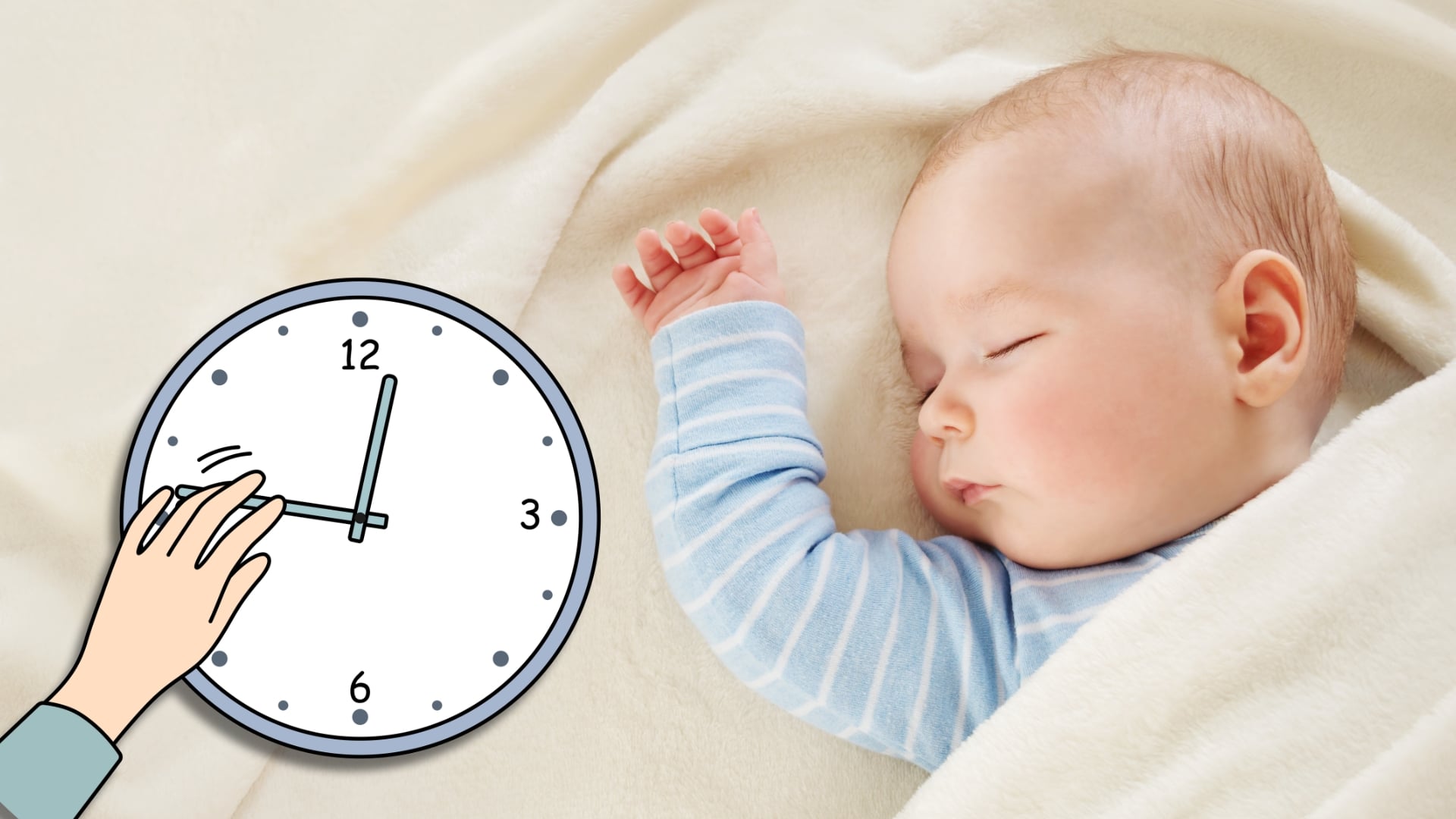
Table of Contents
Key Takeaways
- Prepare for Daylight Saving Time changes in advance by gradually adjusting your baby’s bedtime, wake time, nap schedule, and mealtimes in small increments leading up to the date. This will help ease the transition.
- Maintain consistent bedtime routines and sleep associations (like swaddling and white noise) to give your baby cues that it’s time to sleep. Familiarity and predictability provide comfort during schedule disruptions.
- Be patient through early wake-ups or temporary nap issues. Most babies adjust on their own within 1-2 weeks. Stick to routines and avoid letting baby sleep with you or offering too many night feeds as that can perpetuate sleep challenges.
The Basics of Daylight Savings Time
Daylight Savings Time (DST) is a practice followed in many parts of the world to make better use of natural daylight. In the spring, clocks are set forward by one hour, and in the fall or autumn, they’re set backward.
When DST starts, you’ll notice longer evenings, as sunlight extends further into the night. Then, when DST ends, mornings are brighter, but evenings get darker earlier.
Adjusting to these changes can be challenging, especially for your baby and toddler’s sleep schedules.
Effects Of Daylight Savings On Baby’s Circadian Rhythm
The time change during Daylight Saving Time (DST) affects everyone, including young children.
Babies and toddlers have sensitive circadian rhythms, which regulate their daily routines. When DST comes into effect, their internal clocks are thrown off balance.
This is because, melatonin, a hormone responsible for regulating your baby’s sleep, is affected by light exposure and as the hours of daylight shift.
The disruption to your baby’s melatonin levels can make it harder for them to fall asleep or wake up at their usual times, affecting their nap times, nightly sleep, and overall mood.
Preparing For Daylight Savings And Baby Sleep
As I always say… Prior Planning Prevents Poor Performance.
And when the clocks change, a little bit of preparation can go a long way to helping your baby maintain their sleep routines (helping to keep you sane too):
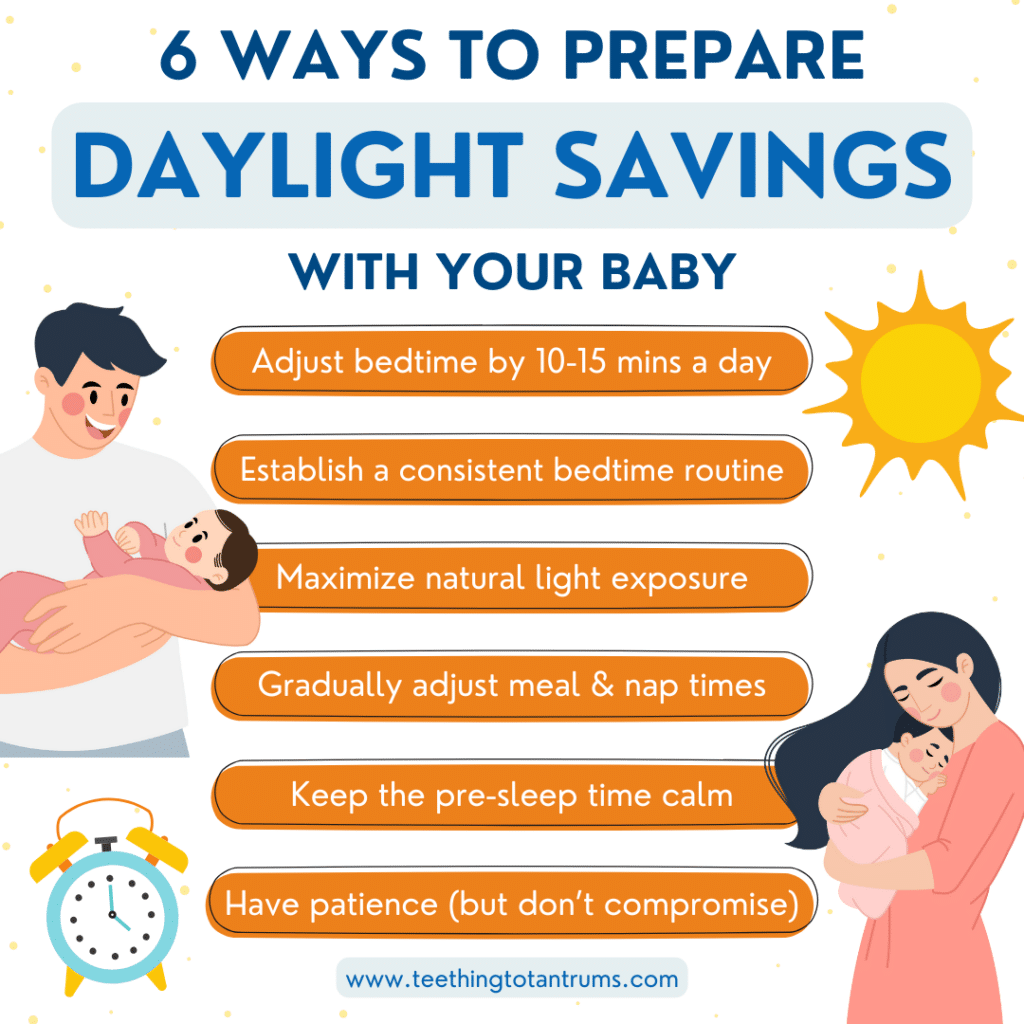
- Adjust bedtime and wake-up time. Start adjusting your baby’s nap and bedtime by 10-15 minutes daily in the week leading up to daylight savings, gradually moving closer to the hour difference in time. Brighten or dim the lights in the evening and morning and use black-out blinds to restrict daylight when needed.
- Establish a consistent bedtime routine. Having a consistent and regular bedtime routine is beneficial all year round… but especially when a time change is approaching. A bedtime routine will give your baby the necessary signs they need to sleep, making time changes during daylight savings far easier to manage. Remember to include familiar comfort items to help your baby relax.
- Maximize natural light exposure. Sunlight helps regulate sleep, so use it to assist in adjusting to daylight savings. When the clocks ‘spring forward’, expose your child to light during the day and darken the sleep environment at night with thick curtains or black-out blinds.
- Gradually adjust meal times and nap times. Shift your baby’s meals and naps in line with their new sleep schedule to avoid disrupting their sleeping routine and internal clock.
- Keep your pre-sleep time calm. Minimize stimulation before putting baby down to sleep during daylight savings by having a cuddle, reading a book, singing a song, or having a bath. This will help your baby feel drowsy and ready for sleep.
- Remember patience is key. Everyone adjusts differently to time changes, so give your baby grace and understanding as they get used to the new schedule. And remember, while daylight savings might disrupt your baby’s sleep, even if you do nothing, most children will adapt to the new schedule in a week or two.
TOP TIP: Don’t be tempted to shorten or cut naps in the lead-up to Daylight Savings. Your baby must continue to get the daytime sleep they need when adjusting to a new sleep schedule to prevent overtiredness.
Daylight Savings Schedule For The Next 5 Years
When adjusting your little one’s schedule to accommodate Daylight Savings, it helps to know when the clocks are going to change so that you can make necessary adjustments to ease their transition to the time change.
In the United States, DST begins on the second Sunday of March and ends on the first Sunday of November.
Here’s a quick overview of DST start and end dates for the next few years for the USA:
| Year | USA Spring Forward DST Date | USA Fall Back DST Date |
|---|---|---|
| 2024 | March 10th | November 3rd |
| 2025 | March 9th | November 2nd |
| 2026 | March 8th | November 1st |
| 2027 | March 14th | November 7th |
| 2028 | March 12th | November 6th |
| 2029 | March 11th | November 5th |
| 2030 | March 10th | November 4th |
However, DST varies from country to country.
For instance, in the UK, we change the clocks on the last weekend in March (spring forward) and the last weekend in October (fall back).
Here are the Daylight Savings Dates for the United Kingdom:
| Year | UK Spring Forward DST Date | UK Fall Back DST Date |
|---|---|---|
| 2024 | March 31st | October 27th |
| 2025 | March 30th | October 26th |
| 2026 | March 29th | October 25th |
| 2027 | March 28th | October 31st |
| 2028 | March 26th | October 29th |
| 2029 | March 25th | October 28th |
| 2030 | March 31st | October 27th |
Looking to get your little one to sleep quickly and effortlessly? Check out my Bedtime and Nap Cheat Sheet and master the art of making daytime naps and bedtimes as seamless as possible.
A bedtime & nap cheat sheet so good your little one will ask you to put them to bed...
Laura Williams "This is a life saver! I'm so glad I downloaded your bedtime & nap cheat sheet. My little one actually asked me to put him to bed last night! Unbelievable! Thank you so much!"
Click Here For The FREE Cheat Sheet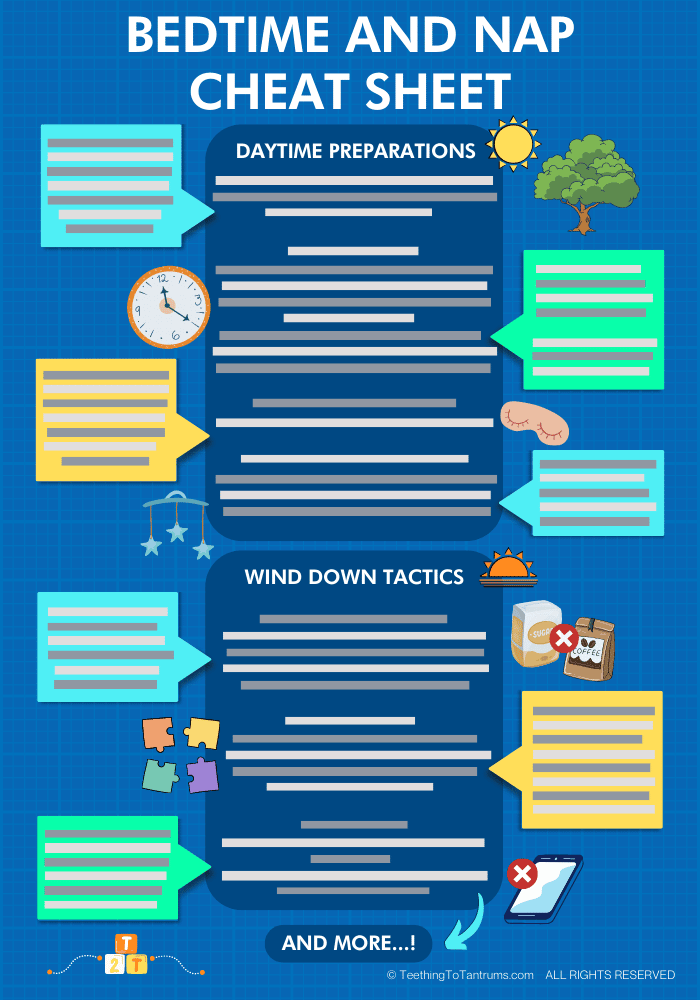
Adjusting Baby Sleep To ‘Spring Forward’ Daylight Savings
The easiest way to adjust your baby’s sleep schedule for the Spring clock change is to shift to an earlier bedtime.
Start by moving your little one’s bedtime 15 minutes earlier each day until you reach the desired hour.
In addition:
- Get outside every day in the natural light to reinforce your baby’s internal clock
- Offer meals and naps 15 minutes earlier each day to help aid the hour transition.
- Have recognizable bedtime and nap routines to signal sleep time
- Be patient and understand that it may take some time for your baby to fully adjust so you will need to be prepared for some potential early wakings and nap disruptions.
Spring Forward Daylight Savings Baby Sleep Schedule
Here is a sample Spring Forward Daylight Savings Baby Sleep Schedule (clocks go forward by 1 hour).
The night before Daylight Savings (Saturday night):
- Maintain your normal bedtime routine. Try to keep things as consistent as possible and help baby drift off to sleep.
On the day of the Clock Change (Sunday):
- Wake baby up at their normal wake-up time, even though it may still seem early. Getting baby up earlier will help adjust their internal clock to the time change.
- If they normally wake up at 6.30am, make sure you maintain this. Even if 6.30am today was 5.30am yesterday, don’t be tempted to wait until your clock says 7.30am (6.30am yesterday)… it will only backfire on you later.
- Plan feeds 15 minutes earlier than normal.
- Watch for baby’s sleep cues during the day and let them nap accordingly. You can always wake your baby up early. Remember, your baby should be awake for 2-3 hours before bedtime.
- Aim for a normal bedtime routine starting 15-30 minutes earlier than usual. You will probably find they’re more than happy to go down to sleep.
Over the next few nights:
- Stick to the earlier bedtime routine you started on the Daylight Savings day.
- Wake baby up at the same earlier time each morning to reinforce the time change.
- Naps may be slightly shorter as baby adjusts. Gradually stretch them back out to normal lengths over the next week.
Sticking to the slightly earlier schedule for about a week should help baby adjust to the time change from Daylight Savings Time. Be patient, as it may take a few days for their internal clock to fully sync up.
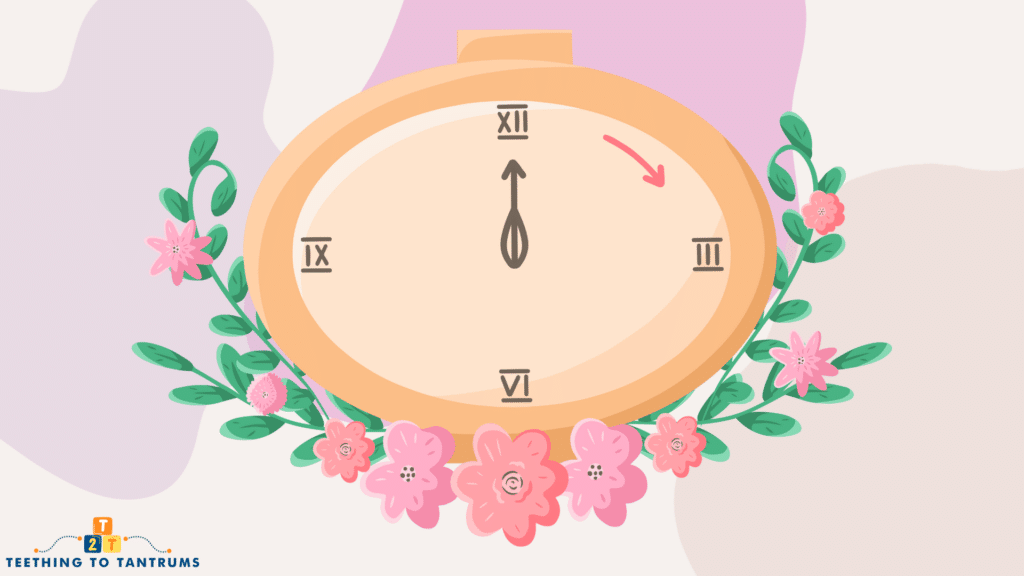
Adjusting Baby Sleep To ‘Fall Back’ Daylight Savings
The most effective technique to help your little one adjust to ‘Fall Back’ daylight savings is to gradually shift their bedtime a little later in the week before the clocks change.
This can be done using small increments, such as 10-15 minutes until you reach the desired time.
During this transition, also keep in mind the following points:
- Maintain a consistent and recognizable bedtime routine to help your baby maintain a sense of familiarity. This should include activities such as a bath, reading a story, or playing calming music or an audio story,
- Move nap times and meal times later by 10-15 minutes each day.
- If your little one is struggling to make it through to the later bedtime during the transition phase, offer a cat nap of no more than 30 minutes in the afternoon to help them make it to the later bedtime.
With all this said and done another approach is to let your baby adjust naturally to the time changes.
In my experience, many babies adjust quite easily within a few days.
However, if you are concerned about the disruption Daylight Savings Time may cause to your little one sleep routine taking the steps laid out will give you more control over the situation.
Fall Back Daylight Savings Baby Sleep Schedule
The clocks going back can often throw a baby off more than the clocks going forward. To help you get through this phase, here is a sample Fall Back Daylight Savings Baby Sleep Schedule (clocks go back by an hour):
The week before Daylight Savings Time:
- Starting about 7 days before, slowly transition bedtime 10-15 minutes later each night until your baby is going to bed 1 hour later than normal.
The night before Daylight Savings (Saturday night)
- Do your normal bedtime routine and put your baby to bed at the later time you’ve been practicing over the last week.
On the day of the Clock Change (Sunday):
- Let baby sleep in a bit later than usual, even if past their normal wake-up time.
- Have feeds a bit later to adjust to the time change. 10-15 minutes later is a good place to start.
- To help prevent overtiredness, your baby’s naps may be slightly longer to compensate.
The week following the Clock Change:
- The later bedtime is now the normal routine. For example, if before the DST your baby went to bed at 7pm and you transitioned to putting baby to bed at 8pm… When the clocks changed, that 8pm has now become 7pm… Baby’s correct bedtime.
- Naps may still be on the long side as your baby adjusts to the “extra” hour of sleep. So, gradually shorten baby’s nap lengths over the next 5-7 days.
- Blackout curtains can help if baby is waking with more sunlight in the mornings.
- Stick to the new later schedule, including on weekends, until fully adjusted.
- It may take a full 7-10 days for baby’s internal clock to sync up to the time change.
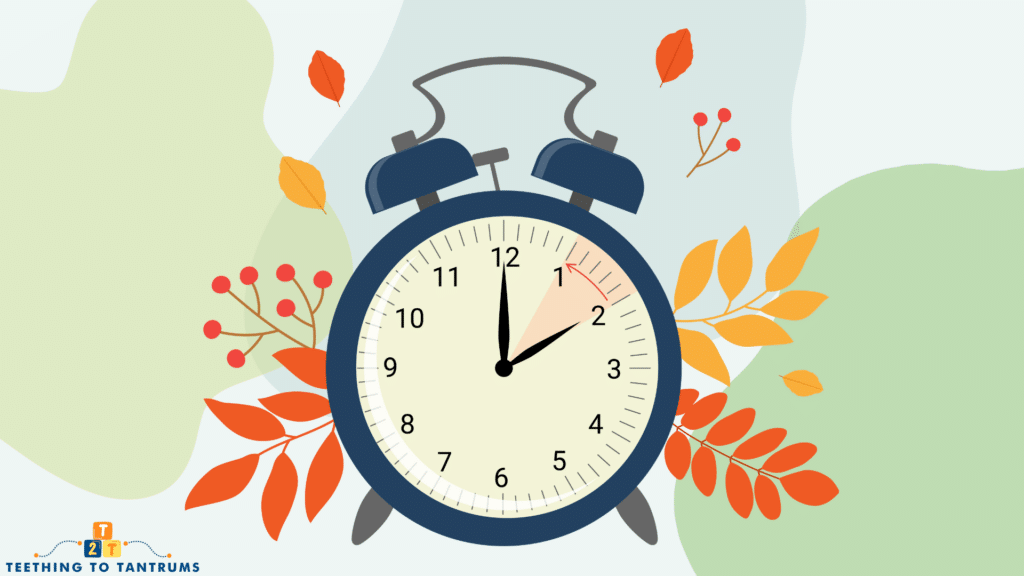
Navigating Nap Times During Daylight Savings
Dealing with nap issues during daylight savings can be challenging as you want to avoid overtiredness at all costs. Here are my top strategies for managing naps when the clocks change:
- Gradually shift naps: In the week leading up to the time change, adjust your baby’s naps by 10-15 minutes each day. This will help them adapt to the new schedule. Keep an eye out for baby sleep cues and act on them as necessary.
- Maintain a calming sleep environment: Keep your baby’s room dark, quiet, and at a comfortable temperature during nap time. Dress them appropriately for the season and ensure they’re relaxed before naptime.
- Be patient with your baby’s sleep schedules: Temporary setbacks are common during daylight savings adjustments. Stick to your routines and give your baby time to adjust. Try your best to not give in to extra cuddles, or let your baby sleep with you… These habits are hard to undo once the clock change has passed.
- Avoid nap transitions: If your baby is close to a nap transition, such as dropping from two naps to one, wait until the time change has passed before adjusting. You will have far better success if you deal with one sleep change at a time!
- Know when to be flexible. If your baby is struggling with naps concentrate on them getting enough daytime sleep over 24 hours. For instance, if the morning nap is longer than normal, consider waking them from their afternoon nap early to ensure they’re tired when their adjusted bedtime comes around.
No matter which approach you decide, you know your baby best so use your knowledge of their temperament and sleep patterns to guide you through the clock change.
Frequently Asked Questions About Baby Sleep During Daylight Savings
Looking for more information about how to handle the daylight savings transition with your baby? Here are the most frequently asked questions, answered just for you.
Q: How can I manage early morning wake-ups with my baby?
A: To manage early morning wake-ups, gradually adjust your baby’s bedtime by 10 minutes each day in the week before the time change. A consistent sleep schedule and exposing them to natural light during the day can also help. Also, try leaving your baby in their crib to see if they resettle by themselves.
Q: How long does it take for babies to adjust to daylight saving?
A: Adjustment time can vary, but it typically takes a week for most babies to adapt to the daylight saving time change.
Q: Can I do nothing and just let my baby adjust to DST their way?
A: Yes, you can just let your little one adjust at their own pace to the new time change. However, be prepared for potential early morning waking or some bedtime resistance. If your baby is struggling to get back on track after two weeks, you might want to consider sleep training or visiting a certified pediatric sleep consultant for more advice.
Q: Baby waking early during daylight savings, what can you do?
A: If your baby is waking early when the clocks change, adjust their bedtime back by 10 minutes a night. Try installing black-out blinds to limit any early morning sunshine and don’t rush in immediately, see if they’ll resettle themselves (the beginning of learning to self-soothe)
Need More Parenting Help?
- Download our FREE Perfect Sleep Cheat Sheet. It’s a free, easy-to-use and proven formula designed for parents of 0-5 year olds to master the art of consistently undisturbed and restful sleep without the yelling, nagging or exhausting long-winded evenings.
- Check out our Parenting Toolbox. You’ll get access to expertly-chosen products that you can guarantee are the best for your little one and your wallet.
- Ready to create the calm, peaceful evenings you deserve? Then checkout our most popular course - The Bedtime Battles Masterclass

A bedtime & nap cheat sheet so good your little one will ask you to put them to bed...
Laura Williams "This is a life saver! I'm so glad I downloaded your bedtime & nap cheat sheet. My little one actually asked me to put him to bed last night! Unbelievable! Thank you so much!"
Click Here For The FREE Cheat Sheet


